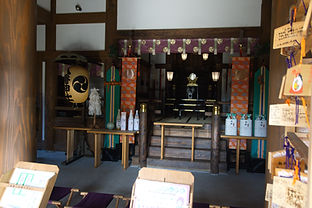普通の外にいくつかの著名な品質を持っている、と畏敬の念を起こさせるあるいかなるビーイングは、カミと呼ばれています。
Nearest station
Setagaya-Daita
Odakyu Odawara Line
Tōkyō-to, Setagaya-ku, Daita 3-57-1
東京都世田谷区代田3-57-1
代田八幡神社
Daita Hachiman Jinja
Home page: None
January 1, 2018
Enshrined Kami:
Main
(Note: numbers in parentheses after kami names
refer to position in How Many Kami table)
Ōjin-tennō 応神天王
From Merged Shrines
None
In-ground Shrines:
None
Earliest mention of: 1591
Annual Festival: 3rd Saturday of September
History
Following the overthrow of the later Hōjō clan at the siege of Odawara in 1590, one of their retainers, the Kira family, lords of Setagaya Castle, secluded itself in the Jissō-in Temple, some three kilometres as the crow flies from the current location of the Daita Hachiman Jinja. A group of seven of the Kira family retainers settled on land which is now the Enjo-in Temple (円乗院, Daita 2-17-3) adjoining the Daita Mitsumine Jinja, and reverted to farming, At that time what is now Daita was called Shimo-Daita and included the areas of Motomura, Nakahara, and Ōhara.
The following year, 1591, the same retainers established the shrine through the kanjō process, enshrining the deity of what is now the Setagaya Hachiman-Gū. Enjo-in became the bettōji for the shrine, and in 1681 a main hall was built near the current shrine grounds under the auspices of the second chief priest of the temple. In 1735 the twentieth chief priest held a formal ceremony to celebrate the transfer of the deity.
According to the Shinpen, a signpost put up during repairs to the shrine tells us that sometime during the Genbun Period (1736-1740) five shrines, Kasuga-sha, Jinmei-sha, Ebisu-sha, Daikoku-sha, and Benten-sha, had been merged into one which becama a subordinate shrine of the Daita Hachiman Jinja.
In 1873 the shrine sold off a large number of trees from its


grounds and used the proceeds to refurbish items such as the stone wall, the main torii, the koma-inu, the stone lanterns, and the temizuya. In 1874 the jinja was given the rank of Sonsha (Village Shrine).In 1879 a new Kagura-den was built but it was badly damaged in a severe thunderstorm in 1880 and it was 1887 before it was finally rebuilt.
In 1941 what had been an affiliate shrine, Ōhara Inari Jinja, was given Sonsha status and became independent. In 1945 much of the shrine was destroyed during the firebombings: the main hall was rebuilt in 1949, the Kagura-den and the assembly hall in 1960. In 2011, celebrations to mark the 420th anniversary of the shrine's founding were held and the Prayer Hall was rebuilt as part of the proceedings.
Description
About five minutes on foot from the south entrance of Setagaya Daita Station. Its main claim to fame is doubtless its main torii. Constructed in 1785, this granite torii in the Myōjin style yields pride of place as the oldest in Setagaya-ku only to the one in Kitami Hikawa Jinja. The space between the 2 vertical pillars is 2.39 metres and at its maximum height it is 3.115 metres. As a result of the Great Kanto Earthquake it tilted over at an alarming angle and it is said that when it was later repaired what had been the front became the rear.
(Click on images to expand them)










